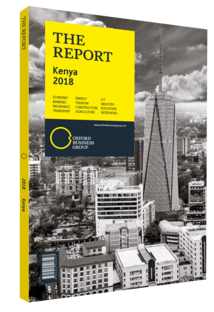Public policy and private investment target Kenyan manufacturing
Released by the Treasury in June 2018, the 2018/19 budget policy statement (BPS) outlined plans to increase state support for the manufacturing segment’s development, while also setting targets for growth and employment across a range of industrial segments. Objectives include increasing manufacturing’s contribution to GDP from 8.4% in 2017 to 15% by 2022, adding approximately $3bn to the economy and generating more than 800,000 new jobs. According to the Kenya National Bureau of Statistics (NBS), manufacturing output in the second quarter of 2018 grew by 3.7% year-on-year to KSh175.7m ($1.7m).
The BPS detailed a range of measures to achieve these aims, including developing value-added facilitators, such as cold-chain and warehousing sites for the agro-processing segment, as well as fast-tracking industrial zones for the leather and fisheries segments. The plans are in line with the government’s wider blueprint for social and economic growth, known as the Big Four agenda. The initiative targets four key pillars of the economy for development over the 2018-23 period: manufacturing, affordable housing, health care and food security. In his December 2017 unveiling of the plan, President Uhuru Kenyatta, said the new manufacturing policy would be based on the subsectors of sustainable fishing and aquaculture, textiles, leather and agro-processing.
Structural Concerns
While some players have welcomed the increased focus on manufacturing, others point to fundamental structural weaknesses in the local economy that need to be addressed to achieve growth targets. Of major concern is the high cost of domestic transport and logistics, which has affected the operating efficiency of manufacturers, along with problems associated with securing reliable access to energy. The national drive to provide manufacturers with improved access to power will include closing gaps in supply, bolstering distribution and addressing cost concerns. Providing universal access to affordable electricity by 2022 by increasing the use of renewables was also outlined in the BPS.
Further support is expected to come in the form of continued investment in transport and logistics infrastructure, notably through the ongoing, multibillion-dollar Lamu Port-Southern Sudan-Ethiopia Transport corridor programme. In addition to improving rail and road links between eastern Kenya and neighbouring countries, the project involves the development of the 32-berth Lamu Port and construction of an 865-km oil pipeline linking the Lokichar Basins in Turkana County to a refinery at the port. Officials announced in February 2018 that terminal one at Lamu Port should begin operations by late 2018, with ground already broken on three berths at the facility.
Major Expansions
Despite challenges, the manufacturing sector has steadily been gaining momentum in recent years, with several major players expanding their operations. In September 2017 multinational consumer goods manufacturer Bidco Africa opened a KSh2bn ($19.6m) detergent factory at its main facility in Thika, with initial production set at 3000 tonnes per month. The firm also launched a juice manufacturing facility in the Tatu park after entering into a partnership with the Danish company CO-RO. In October 2017 Kenyan firm Chandaria Industries, one of the largest tissue paper and hygiene product manufacturers in East and Central Africa, began work on a second manufacturing plant at Tatu Industrial Park in Riuru. Chandaria aims to double annual production capacity to 29,000 tonnes and create an additional 1000 jobs when the KSh5bn ($49m) facility opens.
The projects form part of a longer-term, KSh200bn ($2bn) expansion drive by Bidco, which includes opening several new factories at the Tatu site and building a new self-contained industrial park. Vimal Shah, the group’s chairman, told local media in 2017 that Bidco was looking to create 2000 jobs within the park and approximately 200,000 others within its ecosystem.
You have reached the limit of premium articles you can view for free.
Choose from the options below to purchase print or digital editions of our Reports. You can also purchase a website subscription giving you unlimited access to all of our Reports online for 12 months.
If you have already purchased this Report or have a website subscription, please login to continue.

